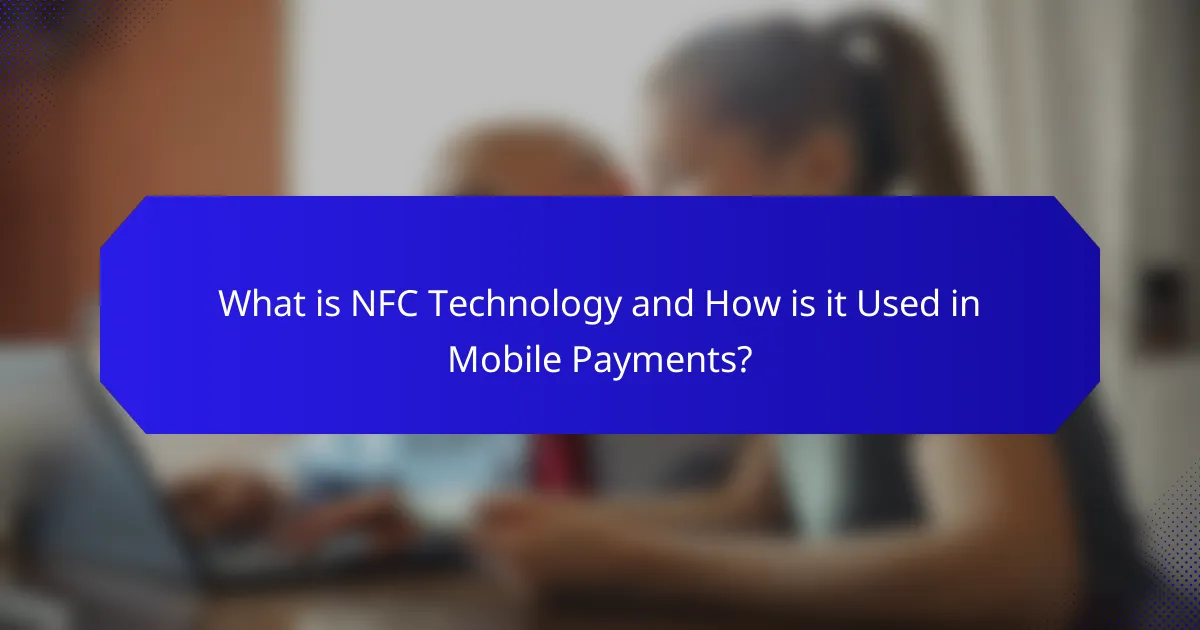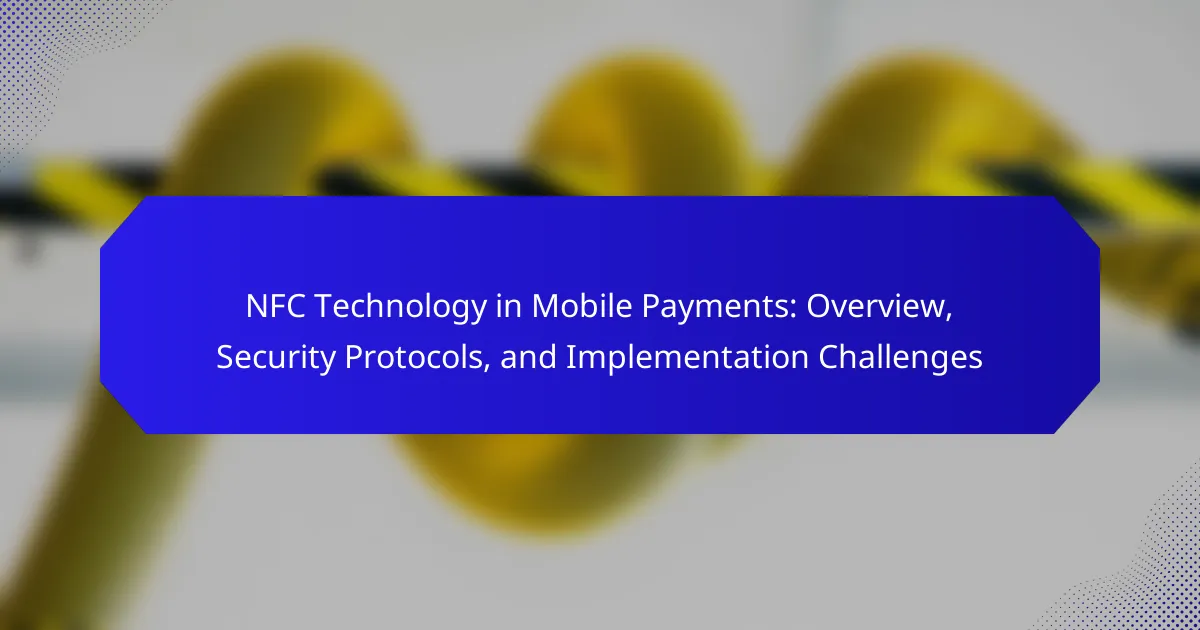NFC technology, or Near Field Communication, is a communication protocol that enables electronic devices to exchange data when in proximity, typically used in mobile payments. This technology facilitates secure transactions by allowing users to tap their smartphones against payment terminals, utilizing encryption and tokenization to protect sensitive information. The article explores the security protocols associated with NFC payments, including Secure Element, Host Card Emulation, and Transport Layer Security, which ensure safe transactions. It also addresses the implementation challenges businesses face, such as hardware compatibility, security vulnerabilities, consumer awareness, regulatory compliance, and the costs associated with adopting NFC solutions. The increasing adoption of NFC technology is underscored by projections of the mobile payment market reaching over $12 trillion by 2025.

What is NFC Technology and How is it Used in Mobile Payments?
NFC technology, or Near Field Communication, is a set of communication protocols that enables two electronic devices to communicate when they are brought close together. It is commonly used in mobile payments to facilitate transactions between smartphones and payment terminals. NFC allows users to make secure payments by simply tapping their device against a compatible terminal. This process involves the transfer of payment information over short distances, typically within 4 centimeters. The technology relies on RFID (Radio Frequency Identification) principles and operates at a frequency of 13.56 MHz. NFC payments are secure due to encryption and tokenization methods that protect sensitive information. According to a report by Statista, the global mobile payment market is projected to reach over $12 trillion by 2025, highlighting the growing adoption of NFC technology in this sector.
How does NFC Technology facilitate mobile transactions?
NFC technology facilitates mobile transactions by enabling short-range wireless communication between devices. It allows smartphones to communicate with payment terminals through electromagnetic fields. Users simply tap their mobile device against a compatible terminal to initiate a payment. This process is quick and eliminates the need for physical cards or cash. According to a study by Juniper Research, NFC transactions are projected to exceed $1 trillion by 2024. This growth highlights the increasing adoption of NFC in retail environments. The technology also enhances security through encryption and tokenization, protecting sensitive payment information.
What are the key components of NFC Technology?
The key components of NFC technology are the NFC controller, NFC antenna, and NFC-enabled devices. The NFC controller processes communication and manages data transfer. The NFC antenna enables wireless communication between devices. NFC-enabled devices include smartphones, tablets, and payment terminals. These components work together to facilitate secure and short-range data exchange. NFC operates at a frequency of 13.56 MHz, allowing communication over distances up to 4 centimeters. This technology supports various applications, including mobile payments, access control, and data sharing. Each component is essential for the functionality and effectiveness of NFC technology in real-world scenarios.
How does the communication process work in NFC transactions?
NFC transactions involve a communication process that utilizes radio frequency identification (RFID) technology. Two devices, typically a reader and a tag, establish communication through electromagnetic fields. The reader generates a field that powers the tag when in proximity, usually within 4 centimeters.
Once activated, the tag sends data back to the reader using amplitude shift keying (ASK) modulation. This data exchange can include payment information or other transaction details. NFC operates in three modes: card emulation, reader/writer, and peer-to-peer.
In card emulation mode, a mobile device acts like a contactless card. In reader/writer mode, the mobile device reads information from NFC tags. In peer-to-peer mode, two NFC-enabled devices can exchange data directly.
The communication process is rapid, typically completing transactions in less than a second. Security protocols, such as encryption and tokenization, enhance the safety of NFC transactions. These features ensure that sensitive information is protected during the communication process.
What are the advantages of using NFC Technology for payments?
NFC technology offers several advantages for payments. First, it enables contactless transactions. This speeds up the payment process, reducing wait times at checkout. NFC payments are also secure due to encryption and tokenization. These features protect sensitive information during transactions. Additionally, NFC technology enhances user convenience. Users can make payments using smartphones or wearables without needing cash or cards. According to a study by Juniper Research, contactless payments are expected to reach $6 trillion by 2024. This growth indicates widespread adoption and trust in NFC payment systems.
How does NFC Technology enhance user convenience?
NFC technology enhances user convenience by enabling quick and effortless transactions. It allows users to make payments by simply tapping their devices on a compatible terminal. This eliminates the need for cash or physical cards, streamlining the payment process. NFC technology also supports contactless ticketing for public transport and events, further simplifying access. According to a study by Juniper Research, contactless payments are expected to reach $6 trillion by 2024, demonstrating growing user preference for convenience. Additionally, NFC facilitates easy pairing of devices, such as connecting to speakers or sharing files, enhancing overall user experience.
What cost benefits does NFC Technology provide to businesses?
NFC technology provides significant cost benefits to businesses by reducing transaction costs and improving operational efficiency. It minimizes the need for physical cash handling, which lowers labor costs associated with cash management. NFC transactions typically have lower fees compared to traditional payment processing methods. According to a study by Juniper Research, businesses can save up to 30% on transaction fees by adopting NFC payments. Additionally, NFC technology speeds up the checkout process, enhancing customer satisfaction and potentially increasing sales. This efficiency can lead to lower overhead costs in retail environments. Overall, NFC technology presents a compelling financial advantage for businesses looking to streamline payment processes.

What Security Protocols are Associated with NFC Technology in Mobile Payments?
NFC technology in mobile payments utilizes several security protocols to ensure safe transactions. Key protocols include Secure Element (SE), Host Card Emulation (HCE), and Transport Layer Security (TLS). The Secure Element securely stores sensitive data, such as payment information. Host Card Emulation allows mobile devices to emulate a smart card for transactions. Transport Layer Security encrypts data transmitted during the payment process. Additionally, NFC uses tokenization to replace sensitive card data with unique identifiers. These protocols collectively enhance security by protecting user data from unauthorized access.
What are the primary security features of NFC Technology?
The primary security features of NFC technology include encryption, secure elements, and tokenization. Encryption protects data transmitted between devices, ensuring that sensitive information remains confidential. Secure elements are dedicated hardware components that store sensitive data securely. Tokenization replaces sensitive data with unique identifiers, reducing the risk of data breaches. Additionally, NFC technology utilizes proximity-based communication, which limits the range of potential attacks. These features collectively enhance the security of mobile payments using NFC technology.
How does encryption protect NFC transactions?
Encryption protects NFC transactions by converting sensitive data into a secure format that is unreadable without a decryption key. This process ensures that information such as payment details remains confidential during transmission. When a user initiates an NFC transaction, encryption algorithms scramble the data, making it difficult for unauthorized parties to interpret.
For instance, AES (Advanced Encryption Standard) is commonly used for securing NFC communications. This standard provides a high level of security, making it challenging for attackers to access or manipulate the data. Additionally, encryption helps prevent replay attacks, where an attacker could capture and reuse transaction data.
By requiring a decryption key, encryption ensures that only authorized devices can access the original information. This mechanism significantly reduces the risk of fraud and enhances user trust in NFC payment systems.
What role do secure elements play in NFC security?
Secure elements are critical components in NFC security. They provide a secure environment for storing sensitive information. This includes encryption keys and payment credentials. Secure elements protect against unauthorized access and tampering. They ensure that transactions are conducted securely between devices. By isolating sensitive data, they mitigate risks associated with data breaches. The use of secure elements is mandated by industry standards like EMVCo. This enhances trust in mobile payment systems, fostering wider adoption.
What are the potential security risks of NFC Technology?
NFC technology presents several potential security risks. One significant risk is eavesdropping, where unauthorized parties can intercept data exchanged between devices. This occurs because NFC operates over short distances, making it susceptible to interception if devices are too close. Another risk is data corruption, where malicious actors can alter transmitted information during the communication process. Additionally, there is the threat of relay attacks, where an attacker relays messages between two devices to deceive them into thinking they are communicating directly. Device theft or loss also poses a risk, as stolen devices can be used to access sensitive payment information. Furthermore, lack of proper encryption can expose transmitted data to unauthorized access. According to a study by the University of Cambridge, nearly 60% of NFC-enabled devices lack adequate security measures, increasing vulnerability to attacks.
How can users protect themselves from NFC-related fraud?
Users can protect themselves from NFC-related fraud by taking several proactive measures. First, they should disable NFC functionality when not in use. This prevents unauthorized access to the device. Second, users should regularly monitor their bank statements and transaction history for any suspicious activity. Quick detection of unauthorized transactions can mitigate potential losses. Third, using strong passwords and biometric authentication adds an extra layer of security. This makes it harder for fraudsters to access sensitive information. Fourth, users should be cautious when making payments in crowded areas. Thieves may use devices to scan NFC signals without the user’s knowledge. Finally, keeping software and apps updated ensures that users benefit from the latest security patches. According to the Federal Trade Commission, these practices significantly reduce the risk of fraud.
What measures can businesses implement to enhance NFC security?
Businesses can enhance NFC security by implementing strong encryption protocols. This protects data transmitted during NFC transactions. They should also use secure elements within devices to store sensitive information. Regular software updates are crucial to patch vulnerabilities. Additionally, businesses can employ tokenization to replace sensitive data with unique identifiers. Educating staff about security best practices reduces human error. Monitoring transactions for unusual activity can help detect fraud. Finally, using multi-factor authentication adds an extra layer of security. These measures collectively strengthen NFC security and protect consumer data.

What Implementation Challenges Do Businesses Face with NFC Technology?
Businesses face several implementation challenges with NFC technology. One major challenge is the need for compatible hardware. Many existing devices may not support NFC, requiring upgrades. Another challenge is ensuring security. NFC transactions can be vulnerable to interception if not properly secured. Integration with existing payment systems also poses difficulties. Businesses must ensure seamless compatibility with their current infrastructure. Additionally, consumer awareness is limited. Many customers may not understand or trust NFC payments. Regulatory compliance can also be complex. Businesses must navigate various legal requirements related to data protection. Finally, the cost of implementing NFC solutions can be significant. This includes expenses for new hardware, software, and training staff. These challenges can hinder the widespread adoption of NFC technology in mobile payments.
What are the common obstacles to adopting NFC Technology?
Common obstacles to adopting NFC technology include security concerns, lack of awareness, and infrastructure limitations. Security concerns arise due to potential data breaches and fraud. Many users fear their personal information may be compromised during transactions. Lack of awareness hinders adoption, as many consumers and businesses do not understand NFC technology’s benefits. Infrastructure limitations exist, as not all merchants have compatible payment systems. Additionally, high implementation costs can deter businesses from upgrading their systems. Compatibility issues with existing devices further complicate adoption. According to a study by the International Journal of Information Management, these factors significantly impact the growth of NFC technology in mobile payments.
How do compatibility issues affect NFC implementation?
Compatibility issues hinder NFC implementation by limiting device interoperability. Different NFC standards exist, such as NFC-A, NFC-B, and NFC-F. Devices must support the same NFC standard to communicate effectively. If a device uses a different standard, it may fail to connect. This situation can lead to user frustration and reduced adoption rates. Additionally, software incompatibilities can arise from varying operating systems. For example, Android and iOS may handle NFC differently. These discrepancies can prevent seamless transactions. Consequently, businesses may face challenges in integrating NFC solutions. Overall, compatibility issues can significantly impede the widespread use of NFC technology in mobile payments.
What infrastructure challenges must businesses address?
Businesses must address several infrastructure challenges related to NFC technology in mobile payments. These challenges include ensuring compatibility with existing payment systems. Many businesses still rely on legacy systems that may not support NFC transactions. Upgrading infrastructure can be costly and time-consuming.
Additionally, businesses must focus on security protocols to protect sensitive customer data. NFC technology can be vulnerable to hacking if not properly secured. Implementing robust encryption and authentication measures is essential.
Moreover, businesses face challenges in consumer adoption of NFC technology. Many customers may be unfamiliar with mobile payments or hesitant to use them. Educating consumers and providing incentives can help increase adoption rates.
Lastly, maintaining reliable connectivity is crucial for seamless transactions. Businesses must ensure strong network coverage to prevent disruptions during payment processing. These infrastructure challenges require strategic planning and investment to effectively implement NFC technology in mobile payments.
What best practices can help overcome NFC implementation challenges?
To overcome NFC implementation challenges, organizations should prioritize thorough planning and stakeholder engagement. Conducting a comprehensive needs assessment is crucial. This ensures all requirements are identified before implementation begins. Training staff on NFC technology enhances user understanding and reduces errors. Collaborating with experienced vendors can provide valuable insights and support. Testing NFC systems in controlled environments helps identify potential issues early. Ensuring compliance with industry standards and regulations is essential for security and interoperability. Regularly updating software and hardware maintains system integrity and performance. These practices collectively enhance the success of NFC implementation in mobile payments.
How can businesses ensure a smooth transition to NFC payments?
Businesses can ensure a smooth transition to NFC payments by adopting a structured implementation plan. This plan should begin with thorough staff training on the new technology. Employees must understand how to use NFC systems effectively. Next, businesses should assess their current payment infrastructure. Upgrading hardware and software may be necessary to support NFC functionality.
Additionally, businesses should communicate the benefits of NFC payments to customers. This communication can enhance customer acceptance and usage. Testing the system in a controlled environment is crucial before full deployment. This allows for troubleshooting and adjustments.
Finally, gathering customer feedback post-implementation can help refine the process. According to a study by Juniper Research, NFC transactions are expected to reach $1 trillion by 2024, indicating a growing trend in mobile payments.
What resources are available for businesses looking to implement NFC Technology?
Businesses looking to implement NFC technology can access various resources. They can consult industry standards from organizations like the NFC Forum, which provides guidelines and specifications. Technical documentation and SDKs are available from major NFC chip manufacturers such as NXP Semiconductors and STMicroelectronics. Online courses and webinars from platforms like Coursera and Udemy offer training on NFC implementation. Additionally, consulting firms specializing in mobile payments can provide tailored advice and strategies. Industry conferences and trade shows also present networking opportunities and insights into the latest NFC developments.
NFC Technology, or Near Field Communication, is a set of communication protocols enabling secure mobile payments through short-range wireless communication between devices. The article provides an overview of NFC technology, detailing its components, advantages, and the communication process involved in mobile transactions. It also examines the security protocols associated with NFC payments, including encryption, secure elements, and tokenization, while addressing potential security risks and user protection measures. Additionally, the article discusses the implementation challenges businesses face when adopting NFC technology, including infrastructure limitations and compatibility issues, and outlines best practices for a successful transition to NFC payments.
